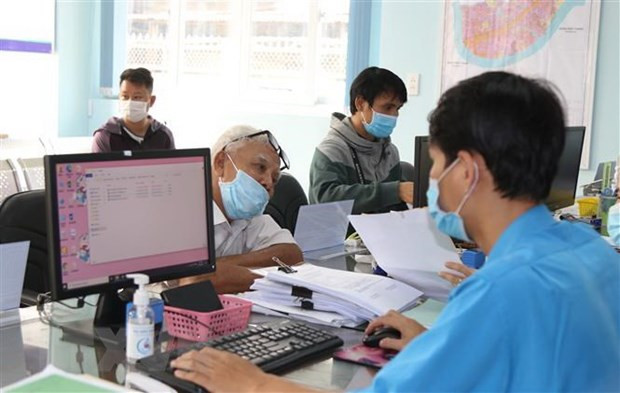One of the outstanding results in implementing the National Assembly's resolution on the field of internal affairs in recent times is the innovation and arrangement of the State administrative apparatus to be streamlined and effective.

From November 6-8, the National Assembly will conduct a question and answer session.
At the beginning of the question-and-answer session, Deputy Prime Minister Tran Luu Quang will present a report on the implementation of a number of resolutions of the 14th National Assembly on thematic supervision and questioning and the National Assembly's resolutions on thematic supervision and questioning from the beginning of the 15th term to the end of the 4th Session.
One of the outstanding results in implementing the National Assembly's resolution on the field of internal affairs in recent times is the reform of the State administrative apparatus.
Streamline the apparatus
Implementing the Party's policy in Resolution No. 18-NQ/TW on continuing to innovate and reorganize the political system to be streamlined, effective and efficient, and the National Assembly's requirements in Resolution No. 56/2017/QH14, the Government has directed ministers, heads of ministerial-level agencies and agencies under the Government to proactively review and reorganize organizations within ministries and branches such as general departments, bureaus, divisions and organizations within general departments to ensure streamlining, effective and efficient operations. Accordingly, 17 general departments and organizations equivalent to general departments have been reduced; 8 departments under general departments and ministries have been reduced; 145 departments/divisions under general departments and ministries have been reduced; and departments within departments have been basically reduced.
The arrangement and consolidation of specialized agencies under the People's Committees at provincial and district levels are also focused on. In addition to issuing relevant decrees, the Government directs ministries managing sectors and fields, People's Committees at provincial and district levels to proactively arrange the organizational apparatus and the number of deputy heads of departments and divisions in the direction of streamlining, reducing intermediate levels, operating effectively and efficiently, meeting the criteria for establishing organizations and the number of deputy heads according to regulations. Accordingly, 7 departments and 2,159 divisions under departments and under People's Committees at district level have been reduced.
Regarding the number of deputies, based on the Government's regulations on criteria for determining the number of deputies in administrative organizations, after the organizational arrangement of ministries and branches, it will be necessary to reduce according to the roadmap for 61 general department-level leaders (14 general directors and 47 deputy general directors), 17 department-level leaders of ministries, 63 department-level leaders of ministries, 404 department-level leaders of general departments. From the results of the administrative organization arrangement, localities have reviewed and restructured the leadership and management personnel at all levels under their management. For organizations that have increased the number of deputies due to mergers and consolidations, the arrangement will be according to the prescribed roadmap.
Regarding the arrangement of focal points of public service units, as of June 30, 2022, ministries and branches have 1,035 units left, a decrease of 98 units (8.6%); localities have 46,653 units left, a decrease of 7,631 units (14.05%).
Implementing the Government's regulations on autonomy of public service units, ministries, branches and localities have proactively reviewed and approved the Autonomy Project for public service units under their management to serve as a basis for implementing the goal of having 10% of public service units financially autonomous as required in Resolution No. 19-NQ/TW.
The Ministry of Home Affairs said that 23 ministries, branches and localities have successfully transformed public service units into joint stock companies; in which the two localities that have completed the transformation of the most public service units into joint stock companies are Hau Giang (6 units) and Quang Nam (9 units). However, the transformation of public service units into joint stock companies is still slow, accounting for only 24.2% of the number of public service units approved for transformation into joint stock companies in the 2017-2020 period.
Besides, during the implementation process, some localities have not closely followed the regulations (7 localities issued Decisions approving the conversion plan without receiving authorization documents from the Prime Minister).
Streamlining staff
Along with the arrangement and streamlining of the apparatus, the number of civil servants and career staff has also been significantly reduced. The number of civil servants in State administrative agencies and organizations under the Government's management in 2021 is 247,722, down 10.01% compared to 2015, achieving the target according to the Party's resolution.

The number of public service employees receiving salaries from the State budget in public service units in 2021 was nearly 1.79 million people, down 11.67% (of which ministries and branches decreased by 25.19%; localities decreased by 10.51%), exceeding the target of a minimum reduction of 10% according to the Party Resolution. This is an outstanding effort of the entire political system and the highest result ever achieved.
To ensure the implementation of the goal of reducing the number of civil servants and public employees receiving salaries from the state budget by 5% by 2026 compared to 2021, the Politburo has issued decisions to assign payrolls for the 5-year period from 2022-2026 to agencies of the political system; The Prime Minister has issued decisions approving the payrolls of civil servants receiving salaries from the state budget of state administrative agencies and organizations under ministries, ministerial-level agencies, agencies under the Government, organizations established by the Government and the Prime Minister that are not public service units, and payrolls of mass organizations assigned tasks by the Party and the State at the central level.
According to Regulation No. 70-QD/TW on the management of the political system's payroll, the Politburo has assigned the authority to manage payroll to the Central Organizing Committee, which is the standing body of the Central Steering Committee on payroll management of provincial and municipal Party Committees; the Government Party Personnel Committee directly manages the payroll of ministries, ministerial-level agencies, and agencies under the Government; organizations established by the Government and the Prime Minister; Vietnamese representative agencies abroad; central public service units; mass organizations assigned tasks by the Party and the State in the central government; and civil servants in public service units.
The Central Steering Committee on Staff Management reviews and decides on the use of reserve staff (the competent authority assigns and manages the staff of the political system's sectors and branches and does not manage reserve staff as in the previous period).
Streamlining staffing is not yet associated with restructuring and improving the quality of the team.
However, the Government pointed out that the arrangement of the State administrative apparatus, the innovation of public service units, and the management of payroll still have shortcomings and limitations. Some sectors and fields, according to the provisions of specialized laws, still require the coordinated management of many ministries. However, the coordination work is still limited, so the effectiveness and efficiency of management for these sectors and fields are not high. It is necessary to continue reviewing legal documents related to sectors and fields under the management scope to amend, supplement or issue new ones to overcome limitations and difficulties, ensure the streamlining of the apparatus, and improve the effectiveness and efficiency of operations.

The arrangement and reduction of focal points of public service units in some sectors and fields are still mechanical; there has not been any real change in the operating mechanism and quality of service provision. The transfer of public service units providing public service of ministries and sectors to local authorities for management and implementation is still slow.
The progress of converting public service units to an autonomous mechanism is still slow, the level of autonomy in public service sectors is uneven. The implementation of socialization in public service sectors and sectors is uneven, often concentrated in a number of sectors, fields, and types that are easy to make a profit and concentrated in areas with developed economic conditions due to unsynchronized policies and not attractive enough to attract socialized resources to invest in the public service sector, especially in difficult areas.
The conversion of public service units into joint stock companies is still slow, mainly stopping at the level of reviewing and making a list of public service units eligible to convert into joint stock companies. Many public service units are very small in scale, have insignificant assets, and almost no brand value, making the conversion into joint stock companies ineffective, and the budget collected after the conversion is insignificant.
A notable issue in payroll management is the outdated payroll norms, issued before the 6th Central Conference of the 12th tenure but not yet revised by ministries managing sectors and fields, especially in the education and training sector, which accounts for nearly 80% of payrolls receiving salaries from the state budget.
Some agencies and organizations are performing state management functions according to a special mechanism (the employees are not included in the civil servant quota assigned by the competent authority), so it is necessary to report to the competent authority for unified management solutions. In addition, the results of implementing the policy of streamlining the payroll are not really linked to restructuring and improving the quality of the staff, civil servants and public employees.
According to VNA